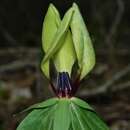pt-BR
nomes no trilho de navegação


Although it is present in areas with higher average temperatures, Trillium lancifolium prefer areas where cold weather occurs seasonally (Hanzawa 1993). Trillium lancifolium often blooms in late winter with erect, odorless flowers and bears purple, angular, berry-like fruits (Rafinesque, 1890). Within the genus Trillium, both flowers and fruits of many species are considered poisonous, however deer commonly feed on certain species in the spring (Vellend 2005). Some species of Trillium have properties that make them useful as expectorants, astringents, and uterine stimulants, which has led to the adoption of the common name “birthwort” (Vellend 2005). Leaves of some species of Trillium may be cooked and eaten as one might prepare spinach (Case 1997). The seeds of Trillium grandiflorum for example are often dispersed by ants which consume and defecate the seeds unharmed which can then germinate (Hanzawa 1993). Although this fact is attributed specifically to Trillium grandiflorum, further study could prove this method of dispersal applicable to other species such as Trillium lancifolium. The seeds germinate and form roots, but the cotyledon does not become photosynthetic until the second season of growth (Hanzawa 1993). After maturation in the seventh growing season, some species of Trillium can live for over 70 years (Knight 2006).
Trillium lancifolium are extremely rare plants in the southeastern states of the United States of America. They are found in Tennessee, Florida, Georgia, Alabama, Mississippi, and South Carolina, and are considered endangered in the states Tennessee and Florida (uswildflowers 2011). One reason these plants could be endangered is because of either the lack of pollinators or the lack of pollen distribution (Sawyer 2009). The breeding system of the Trillium lancifolium has yet to be fully discovered, but Trillium lancifolium produces about two or three flowering offshoots similar to Trillium recurvatum (Ohara, Utech 1986). The eldest shoot eventually dissociates itself and becomes independent on its own (Sawyer 2009). Some information about the seeds are present, such as, its low seed weight and its amount of seeds being extremely smaller than other Trilliums (Ohara 1990). This plant is also considered a spring ephemeral, only appearing in the spring for a very short time. Trillium lancifolium also has pollen limitations; however, reasoning behind this have yet to be found. Trillium lancifolium should be researched more and in depth; there is little information about the cause of rarity for this plant, the asexual reproduction, the breeding system, or reproductive ecology. If scientists wait too long, the plant may become extinct before they get a chance to do more research.
Trillium lancifolium is native to the southeastern region of the United States. States that it is native in include Tennessee, South Carolina, Georgia, Alabama, Mississippi, and Florida (plant.usda.gov). The Trillium lancifolium is a monocot, and is a member of the liliaceae family (plant.usda.gov). Trillium lancifolium is a vascular plant that lacks woody tissue and is found at or above sea level. It should also be noted that Trillium lancifolium is endangered in the states of Tennessee and Florida (plant.usda.gov). The average length of Trillium lancifolium is 8 inches (uswildflowers.com). Trillium lancifolium sprouts flowers from the apex of its stem, and it is either sessile or pedicellate which means that the flower either sits directly on top of the leaves or has a pedicel (edgewoodsgardens.net). Trillium lancifolium sprouts 2 to 3 floral shoots with each shoot producing one flower. The leaves are narrow, and about 2.5 inches longer as they are wide making them anywhere from 3 to 8 inches in length (edgewoodsgardens.net). Trillium lancifolium tends to bloom during the spring time, and during that time it sprouts ovoid pulpy fruit that contains several seeds within it. It should be noted that Trillium lancifolium is one of around 40-45 species of Trillium. All species have three leaves, three sepals, six stamens, three stigmas, and those that are located in North America all have three petals (edgewoodsgardens.net). Trillium lancifolium are woodland plants, and like most woodlands plants they require plenty of moisture when active in growth (edgewoodgardens.net). Trillium lancifolium also require quite a bit of sunlight, however, too much sun will prevent seeds from establishing (edgewoodgardens.net).
Trillium lancifolium is in the family Melanthiaceae, this family is distributed from subarctic to subtropical regions of the Northern Hemisphere (Tamura 1998). The Appalachian mountain area is the center of diversity for Trillium (Tamura 1998). Trillium lancifolium is endangered in North America (Tamura 1998). Trillium lancifolium is often found in soil deposited by water in floodplains (Rafinesque 1840). It can also be found in rocky woodlands, heavy shaded areas, or thin, open woods (Rafinesque 1840). It is often found in elevations between 20 and 200 meters (Rafinesque 1840). Trillium lancifolium is native to Tennessee, Florida, South Carolina, Georgia, Alabama, and Mississippi (Rafinesque 1840). Trillium lancifolium is found in 11 counties in Alabama and 12 counties in Georgia. It has been identified in 4 counties in South Carolina and 3 counties in Florida. In the state of Tennessee Trillium lancifolium can be found in the counties of Hamilton and Marion (Sharp 1964). Trillium lancifolium is listed as endangered in both states of Florida and Tennessee.